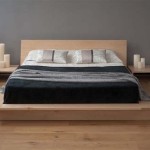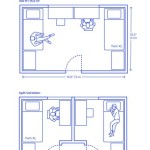Queen vs. King Size Bed Dimensions: Making the Right Choice for Your Bedroom
Choosing the right bed size is a crucial decision for a comfortable and functional bedroom. Two of the most popular choices are queen and king size beds. Understanding their dimensions and the implications of each size can help make the best choice for individual needs and room space.
Queen Size Bed Dimensions
A standard queen size bed measures 60 inches wide and 80 inches long. This size offers ample space for single sleepers and is generally suitable for couples who prefer a closer sleeping arrangement. Queen beds are a versatile option for various room sizes but are particularly well-suited for smaller bedrooms where space is at a premium.
King Size Bed Dimensions
A standard king size bed measures 76 inches wide and 80 inches long, offering considerably more sleeping space than a queen. This extra width provides significant personal space for couples, allowing for comfortable movement without disturbing each other. King size beds, however, require more floor space and may not be suitable for smaller bedrooms.
Comparing Queen and King Size Beds
The choice between queen and king size beds often depends on several factors, including available space, sleeping habits, and budget. A direct comparison of their dimensions highlights the key differences.
Key Dimensional Differences
A king size bed offers 16 inches of additional width compared to a queen size bed. This translates to approximately 38% more sleeping surface. The length of both bed sizes remains the same at 80 inches. This difference in width is significant when considering the comfort and freedom of movement, particularly for couples.
Space Considerations for Each Bed Size
Beyond the bed itself, it’s crucial to consider the space required around the bed for comfortable movement and access. A queen size bed typically requires a room that is at least 10 feet by 10 feet for optimal placement and movement. A king size bed, due to its larger footprint, ideally needs a room that is at least 12 feet by 12 feet.
Impact of Bed Size on Room Layout
The choice of bed size can significantly impact the overall layout and functionality of a bedroom. A larger bed like a king can dominate a smaller room, leaving limited space for other furniture pieces such as nightstands, dressers, and seating areas. Conversely, a queen size bed allows for more flexibility in furniture arrangement and can create a more spacious feel in smaller rooms.
Cost Considerations: Queen vs. King
Generally, king size beds and their associated bedding (sheets, comforters, etc.) are more expensive than queen size options. This price difference is attributed to the increased material required for manufacturing. This cost factor should be considered when budgeting for bedroom furnishings.
Bedding and Accessories
The cost difference extends beyond the bed frame itself. Bedding, including sheets, blankets, and comforters, are typically more expensive for king-size beds. This is due to the increased fabric needed to cover the larger surface area. This price difference should be factored into the overall budget when deciding between bed sizes.
Long-Term Considerations
When choosing a bed size, it's important to consider long-term needs. If there is a possibility of sharing the bed with a partner, children, or pets in the future, a king size bed might be a more suitable option. Conversely, if space is limited and likely to remain so, a queen size bed may be the more practical choice for the foreseeable future.
Visualizing Bed Sizes in a Room
Before making a final decision, it can be helpful to visualize how each bed size will fit in a room. Using painter's tape to mark out the dimensions of a queen and king size bed on the floor can provide a realistic representation of the space each will occupy. This visual aid can greatly assist in making an informed decision.
Measuring Your Bedroom
Accurate measurements of the bedroom are essential for determining the appropriate bed size. Using a measuring tape, record the length and width of the room. This information, combined with the standard dimensions of queen and king size beds, will help determine the optimal size for the available space.
Considering Lifestyle and Sleeping Habits
Individual sleeping habits and lifestyle should also be considered when choosing a bed size. If one tends to toss and turn frequently during sleep, a larger bed like a king might provide more room and prevent sleep disruptions for a partner. Conversely, if a smaller sleeping space is preferred, a queen size bed might be more comfortable.
Consulting Furniture Professionals
For individuals unsure about which bed size is best suited for their needs, consulting with furniture professionals can be beneficial. They can offer expert advice based on individual requirements and room dimensions, helping make an informed decision.

Mattress Sizes Chart And Bed Dimensions Guide Amerisleep

The Difference Between A Queen And King Bed Bedinabox

Queen Bed Dimensions A Guide Nectar Sleep

King Vs Queen Bed Detailed Mattress Comparison Turmerry
Mattress Size Chart And Bed Dimensions Guide 2024

Bed Sizes Guide Curtain Of Maine

Decoding Mattress Sizes And Dimensions Ncoa Org

Decoding Mattress Sizes And Dimensions Ncoa Org

The Ultimate Mattress Size Chart And Bed Dimensions Guide Sleep Advisor

Bed Size Google Search King Dimensions Mattress Sizes







